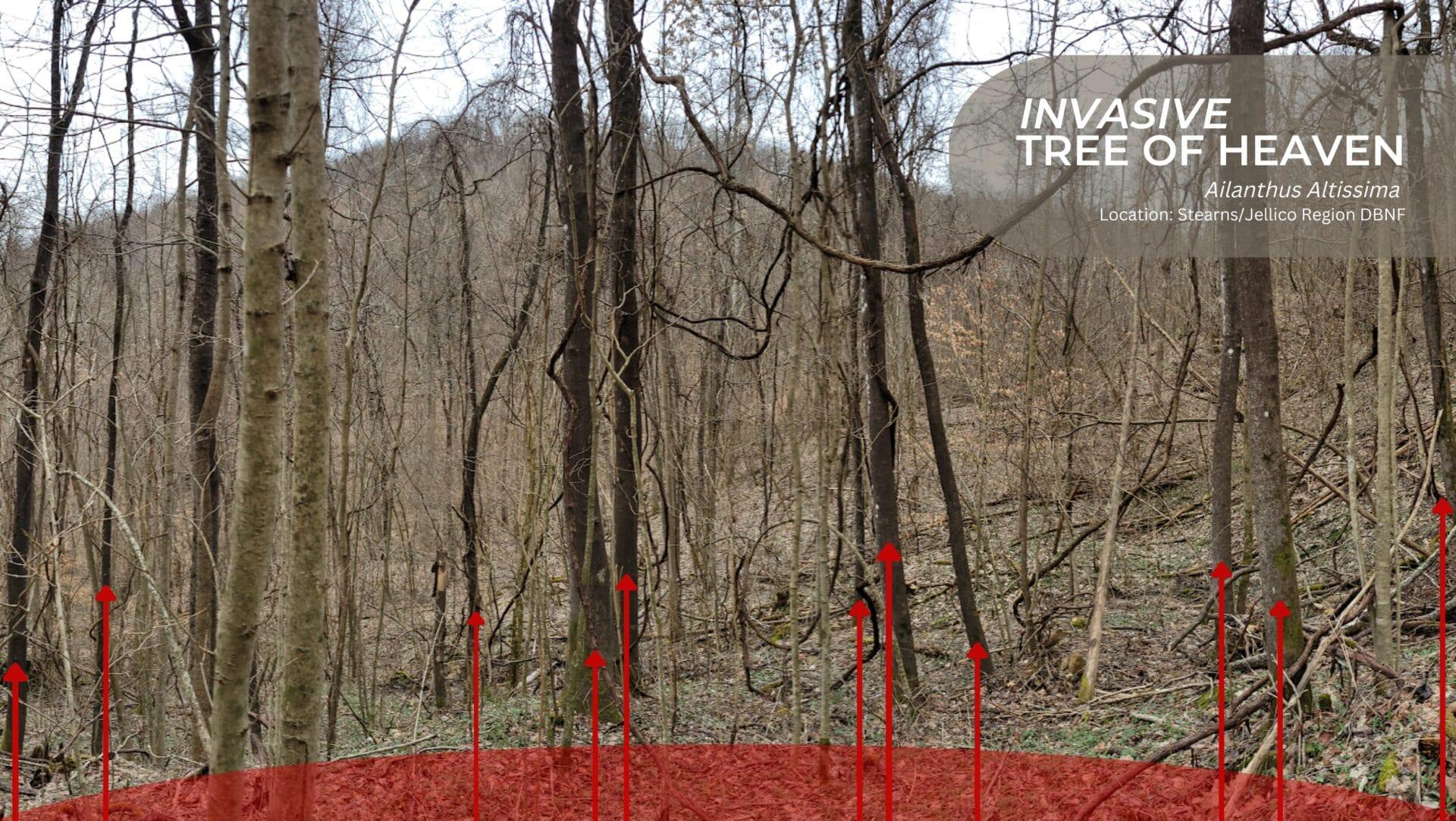Jellico "Vegetation Management" Project
Phase 1: Scoping / October 19, 2022 - Complete
Phase 2: Draft Environmental Assessment / April 24, 2024 - Complete
Phase 3: Objection to Final EA / TBD
Phase 4: Final Decision / TBD
Phase 5: Implementation/ TBD

What you need to know:
10,000 acres and 40 years.
Landslide prone slopes not ideal for logging treatments.
Mature and Old Growth at risk of being logged.
Project Overview:
October, 2022 - The Jellico Vegetation Management Project is a massive logging project that the Daniel Boone National Forest (DBNF) announced in October 2022.
The proposal includes logging on 10,000 acres of national forest in the mountains along the southern border of Kentucky just to the west of I-75 between Williamsburg and Whitley City.
The Forest Service is proposing multiple forms of clearcut on about 5,000 acres and logging nearly half of the total land area on Jellico Mountain. The project would approve logging over an unprecedented 40-year time frame, which is problematic for a number of reasons that we outline below.

Why this forest is special?
The Jellicos are part of the Cumberland Mountains on the Kentucky-Tennessee border. Topping out at about 2,200 feet, and with over 1,200 feet in relief, the Jellicos are more mountainous than the rest of the DBNF.
The area is home to numerous rare species, including the two species of fish that live in Jellico Creek and are protected by the Endangered Species Act – the Cumberland darter (Etheostoma susanae) and Blackside dace (Chrosomus cumberlandensis).
The proposed logging area includes nearly 900 acres of forest that is over 130 years. Due to its age, this older forest should be protected by the Forest Service under an “old-growth” designation, but so far remains on the chopping block.
Resource extraction has already had a heavy toll on the forest. Nearly 2,700 acres were logged in the 1980s and 1990s. In 2011 the Bureau of Land Management and U.S. Forest Service leased over 3,800 acres for oil and gas development. And legacy impacts from coal mining, along with significant problems with invasive plant species, add to the challenges of protecting and restoring this unique area.
Issues
In its current form, the Jellico Vegetation Management Project is practically, ecologically, and legally problematic. There are numerous issues, the most serious of which we describe below:
Landslide risks
This area has steep slopes, unstable soil, and is known to present significant landslide risks. Endangered species rely on the area’s streams for critical habitat, just like the Redbird district where we have documented numerous landslides due to the Forest Service’s logging. We have already documented one landslide in an area logged in the 1990s, and community members have raised their own observations of landslides and erosion following logging in the area.
- Our position: Landslide-prone areas should not be logged, and clearcutting and road building on landslide-prone slopes is grossly unacceptable. The DBNF Forest Plan needs to be amended to designate steep slope areas as “lands not suited for timber production.”
Recreational Opportunity
Jellico contains over 19,000 acres of the National Forest, yet is without a single recreational trail.
- Our position: Work with the community and user groups to assess what types of recreation are compatible and desired in the Jellicos, and develop a plan. There are local, regional, and national efforts underway to work toward the transition of National Forests into National Parks, Monuments, and Recreational Areas. We cannot continue with “business as usual.”
Lack of Details
The project includes 256 stands (groupings) of forest proposed for logging across nearly 10,000 acres in McCreary and Whitley counties. But enough specific information has not been provided about how and when these stands will be cut. This includes what types of logging equipment will be allowed in which areas, where and how logging roads will be built, and how cutting will be distributed across the landscape over the 40-year implementation period.
- Our position: The Forest Service needs to disclose and analyze these and other details in the Environmental Assessment. This is required by the National Environmental Protection Act (NEPA) so that the public can provide meaningful input and the Forest Service can properly evaluate the impacts of the project before making a final decision.
Loss of Mature Forests + Climate Impacts
Mature forests continue to draw down greenhouse gasses as they grow older, contrary to outdated forest models still promoted by the Forest Service and wood products industry. And while young trees can grow quickly, logging results in an overall net release of greenhouse gasses to the atmosphere over many decades to come. While some wood products serve as long-term greenhouse gas storage, logging releases large amounts of greenhouse gasses through milling and mill waste, transportation, soil disturbance, decomposition of slash (tree tops and branches), and other mechanisms. Those greenhouse gasses take decades or longer to be captured again by new tree growth – time we don’t have given current climate models and trajectories.
The Jellico project will result in major greenhouse gas emissions that will not be offset by growth during the life of the project.
Old Growth
The proposed project includes clearcuts on at least 200 acres of old-growth forest (over 130 years old). None of this older forest is protected in the Jellico’s “Designated Old Growth” area despite meeting the Forest Service’s tree size and age requirements for old growth. Kentucky Heartwood's field work is ongoing to ground-truth the parts of the forest proposed for heavy logging, so there could be more old growth to discover.
- Our position: The Forest Service should adhere to President Biden's Executive Order to preserve mature and old growth forests.
Invasive Species
Many areas of these mountains that were logged in the 1980s and 1990s are now overrun with the invasive tree of heaven (Ailanthus altissima), which is also abundant along forest roadsides. These uncontrolled infestations demonstrate that the Forest Service is already doing an inadequate job controlling the invasive species..Opening the tree canopy with logging will only worsen the growth of these species.
- Our position: The Forest Service should address the existing invasive species that are out of control before proposing new logging projects that will worsen the existing situation.
40-year Timeline
The 40-year timeframe for implementing the project presents fundamental flaws in analyzing the project’s impacts and is not compliant with either the National Environmental Policy Act (NEPA) or the National Forest Management Act (NFMA). There is simply no rational way to informed decisions today that approve logging specific areas 20, 30, or even 40 years from now.
- Our position: Planning and implementation horizons for projects on the DBNF, including the Jellico Project, should not extend more than 10 years. The current Forest Plan for the DBNF is out of date, and is not aligned with modern Forest Plan requirements. No new projects should be proposed until the DBNF updates their Forest Plan to adhere to the 2012 Planning Rule. Moreover, the Jellico project is intended to implement an outdated 2004 Forest Plan (the management plan for the DBNF), which was written to guide forest management for “10 to 15 years.” Not only is the forest plan outdated, it was also developed under the 1983 Forest Planning regulations, which were revised in 2012 to shift away from agricultural, “rotational” wood production systems (like what’s proposed in the Jellico project) and toward a more contemporary understanding of sustainability and ecosystem integrity.
Our Position
Conserving mature forests is one of the simplest, most effective means for slowing the effects of climate change. While management decisions shouldn’t be based solely on a forest’s ability to draw down greenhouse gasses, decisions by the Forest Service should be informed by the best, most recent science regarding forests and climate change. The Forest Service should support the development and preservation of mature and old growth forests for both climate resiliency and biodiversity. To do otherwise in a growing climate emergency is irresponsible.
INTERACTIVE MAP OF JELLICO PROJECT
You can navigate this map on a touchscreen by panning with a single finger and changing the view angle and zoom with two fingers. To navigate on a desktop, use the cross icon to pan and the rotating arrow icon to change the view angle.
Interactive map created by staff ecologist, Jim Scheff using data from the U.S. Forest Service
Key:


